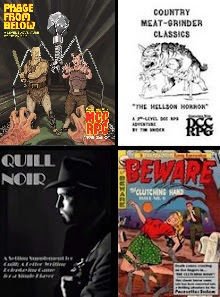(While I'm manning the booth here at Con on the Cob, I thought I'd hammer out a brand new THING for you to torment your Cryptworld players with!)
A Psychotic Artist for Cryptworld
CURATOR
 STR: 4 (60) --- WPR: 5 (75)
STR: 4 (60) --- WPR: 5 (75)DEX: 3 (45) --- PER: 2 (30)
AGL: 4 (60) --- PCN: 3 (45)
STA: 5 (75) --- PWR: 80
ATT: 1/65% --- WND: 15
MV: L 75†
Experience: 750
A Curator is a frustrated artist who, in spite of his passion and drive, has no appreciable talent for the arts. This frustration has built up and exploded into a psychotic maniac determined to prove his artistic merits. And since mankind refuses to recognize his "genius," humanity will now become the bloodsplattered canvas upon which he'll "create."
When creating a Curator, the CM should first determine the medium upon which he works. Once the Curator has kidnapped and slain a victim, the Curator prepares his masterpiece using the following process (roll 1d10):
1. Wax Sculptures -- The Curator dips his victims into molten wax, posing the body before the wax hardens, creating a very lifelike wax figure.
2. Bust Sculptures -- The Curator removes the victim's head, then coats the head in quick-hardening plaster or cement, creating an uncanny human bust.
3. Abstract Paintings -- The chaotic patterns coating the Curator's canvas initially consists of the victim's arterial spray followed by the splatter and drips from various multicolored acrylics.
4. Ceramics -- After removing the victim's limbs, the Curator envelops it in clay, fires it in a kiln, then glazes it as a representation of "the human form."
5. Tile Collage -- The Curator uses broken bits of bones and teeth to create a stark-white collage of "tile" in various eye-pleasing patterns.
6. Watercolors -- The paintings created by the Curator is created with watered-down blood, bile, and other organic fluids of the victim.
7. Photography -- The Curator poses his "models" in lifelike slice-of-life scenes. The photos -- in black-and-white -- capture his vision of a stark realism.
8. Ivory Carving -- Although the artform is frowned upon by some, the Curator can honestly assure the public he never uses ivory taken from live animals. (Live humans are a different matter...)
9. Leatherworking -- The victim's skin is processed into a fine leather canvas by the Curator that is tooled and formed into various forms of leather goods.
10. Music -- The Curator creates beautiful haunting melodies using instruments formed by his victims: a bone flute, a ribcage xylophone, a violin using victim's sinew, etc.
The Curator is very clever and will not begin his killing spree in a haphazard or unplanned manner. He will first kill and "process" a victim in secret, revealing his new artwork to an audience while using his masterpiece power. The audience will be incredibly receptive and praising of the new piece, offering the Curator a place to create and a future gallery showing. With each new masterpiece, the Curator's fame will grow until he has his own museum featuring many of his masterworks (as well as artwork of other, "less talented" artists).
The Curator has usually already established himself in the local artistic culture as an up-and-coming artist before he begins his slaughter. The Curator is egotistical to a fault, seeing himself as the next Great Artistic Talent waiting to be discovered. He is also egotistical as he sees all of his admirers as just "art supplies" for his future projects.
Curator Powers
Masterpiece: The Curator can manipulate an audience's collective mind to impart the impression that the artwork they're viewing is one of the greatest works of art ever created. At a cost of 30 WPR and a successful PWR check, all members of the viewing audience will agree as to the artistic genius of the work. Critics will shower both it and the Creator with praise, and no one will recognize the horrific basis of the artwork's creation. With each future success of the masterpiece power, the Curator establishes himself even further as a wunderkind. Failure of the check means that the work is judged on its own merits. (And harsh critics may find themselves as the "subject" of a future masterpiece.
















































































No comments:
Post a Comment